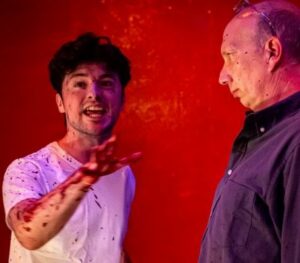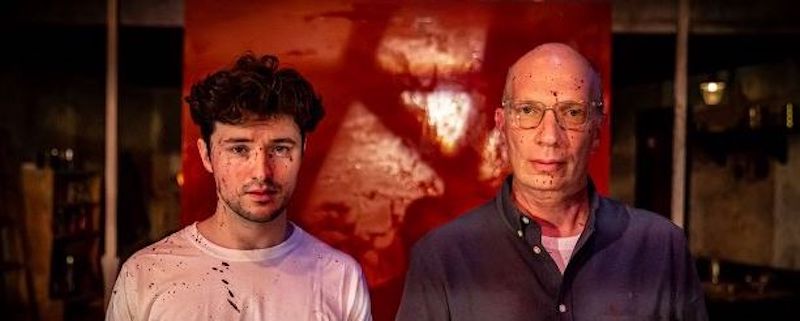Photos by RyLo Media Design, Ryan C. Loyd
The event reviewed here has ended, but please continue reading. To support current and upcoming events, visit the organization’s website for more information.
So . . . SLO REP Artistic Director Kevin Harris claims that Red, John Logan’s one-act one-set play about Mark Rothko now at the downtown SLO theatre, is about the “fierce exploration of the relationship between artists and the art they create.” That’s one way to look at it. Another, brought to life brilliantly in this production, is that it’s about the relationship between people, who as artists build relationships that—perhaps—are reflected in their art.

Perhaps this is quibbling. But Billy Breed (Rothko) and Elliot Peters (Rothko’s fictional assistant Ken) bring such force and grounded reality to their characters that your focus must be on their intense interaction as they go about their day-to-day work. It must be, because the audience is never shown even one of Rothko’s famously fierce paintings.
In his director’s notes accompanying the production, Michael Brusasco makes much of the play’s pitched battle between generations and competing ideas. His precise direction expertly emphasizes this in the choreography of the players as they circle each other in their examination of art, light, life and (it could be argued) the inevitable endgames to such exploration. The format, five uninterrupted scenes with no intermission, gives Breed and Peters the room to make their characters wholly-formed beings as their actions and reactions sometimes enrage the other, sometimes deplete the other, sometimes mirror the other.

The play opens and closes with the same line: “What do you see?” Just because the answer in both cases is supplied in one word—the same word—doesn’t mean that what comes between the lines is simple. The single stage set, artfully constructed by Dave Linfield and Bob Rice, as well as the scenic and prop design attributed to Linfield, are deceptively spare but robustly utilitarian. The lighting by Kevin Harris seems stripped down at first (as an artist’s loft is wont) but its placement and staging in the course of the action proves illuminating in more ways than one, or two.
Music plays an interesting role in the proceedings, rarely commented on by the actors (except to point out differences) but almost always present, whether to underscore grand intentions or subtly nudge the audience in one direction or another, adding another layer of complexity to this rich experience.
And rich this production is. Rich in multiple references to artists and artistic styles, rich in allusions to philosophy and religion, rich in respect to the relationships we develop in order to explain and explore ourselves. And so we come to red . . . Rothko’s reaction to black, to darkness, to the lack of light.
Breed, who is known locally for his many comedic performances, here uses the richness of his voice to demonstrate his refined acting chops. Peters matches Breed line for line with his nuanced reading of an unrefined artist not (ultimately) afraid to engage a master artist in a masterful way. This eruption in scene four (to audience applause, it must be noted) leads to a confrontation in scene five that turns into a virtual game of one-upmanship that sends the younger artist out into the world to “make something new.”
In Red, SLO REP has taken a chance on delivering something novel—or at least nontraditional—to the local theatre-going public: a deceptively simple answer to a complex, intriguing, challenging, and ultimately vital question. What do you see?
